|
|
|
Sort Order |
|
|
|
Items / Page
|
|
|
|
|
|
|
| Srl | Item |
| 1 |
ID:
172168
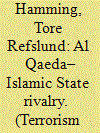

|
|
|
|
|
| Summary/Abstract |
On June 29, 2014, the Islamic State emerged and declared the establishment of its caliphate. The declaration was a direct challenge to other Sunni Jihadi groups including Al Qaeda and an attempt to become the leading Jihadi group around. The rivalry that evolved within Sunni Jihadism, and particularly between Al Qaeda and its renegade affiliate the Islamic State, entailed a hitherto unseen competitive environment within the Jihadi field. Interestingly, the increased competition did not lead to a dynamic of competitive escalation and mutual radicalization of behaviour. Theory tells us to expect competitive escalation, or outbidding, in such contexts, but despite the initial success of the Islamic State’s brutality and offensive conquest in Syria and Iraq, Al Qaeda did not “play along” and instead pursued a different path. The reason for this absence of competitive escalation, this paper argues, is to be found in a pre-conflict methodological re-orientation within Al Qaeda and in the pacifying role played by influential Al Qaeda-affiliated ideologues.
|
|
|
|
|
|
|
|
|
|
|
|
|
|
|
|
| 2 |
ID:
172178


|
|
|
|
|
| Summary/Abstract |
Why do some political radicals—people who believe in using violence for political ends and who may sympathize with local violent groups—not themselves perform violent acts or join violent organizations? This article finds that prior research on terrorism, insurgency, civil war, and ethnic conflict seems to do a poor job of predicting who upon adopting radical political views will actually engage in violence. In fact, there is a great deal of contingency involved in the choice of whether or not to become violent. Employing path dependence, the article treats the radicalizing moment as a “critical juncture,” filled with contingency, but after which actions become more predictable: during this small window of time, radicalized individuals might happen to choose a profession and/or join an organization that is nonviolent, but subsequently become institutionalized as nonviolent actors. The article therefore offers an explanation for how individuals with radical beliefs can be institutionalized as either violent or nonviolent. The study’s findings are based on a content analysis of interviews with 129 nonviolent activists, most of whom exhibited radical beliefs at the time of the interview, and former violent actors, in 12 countries experiencing violent internal conflict.
|
|
|
|
|
|
|
|
|
|
|
|
|
|
|
|
| 3 |
ID:
172195
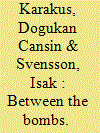

|
|
|
|
|
| Summary/Abstract |
Previous research on ceasefires in armed conflicts has primarily focused on the aggregated country-level of analysis. By contrast, this article contributes by examining the local-level dynamics of local ceasefire arrangements. In particular, this study examines a novel set of 106 local-level ceasefire arrangements in the Syrian Civil War, reached between the years 2011 to 2017. Most (72 percent), but not all, of the ceasefire arrangements were respected during the stipulated time period. We argue that informal and domestic peacemaking should outperform formal and external approaches in managing conflicts with multiple rebel groups, ongoing violence, and different fronts such as in Syria. We find that the presence of insider mediators (“insider-partial”) as well as confidence-building measures between the belligerents are positively associated with successful ceasefire arrangements, whereas explanations emphasized by previous research—external third-party mediation as well as various indicators of quality of agreement—fail to explain outcomes of ceasefires. Yet, we also find some evidence indicative of a selection effect in that external mediators are associated with more difficult conflict situations. The study of local ceasefires in the Syrian Civil War can stimulate further examinations of the micro-dynamics of peacemaking in civil wars, including the causes and consequences of local ceasefires.
|
|
|
|
|
|
|
|
|
|
|
|
|
|
|
|
| 4 |
ID:
172170


|
|
|
|
|
| Summary/Abstract |
This paper applies the concept of “communities of practice” to al-Muhajiroun (“the Emigrants”), an outlawed activist network that seeks to create an Islamic caliphate in Britain and the West through activism and proselytizing. Responding to recent studies on terrorism learning and adaptation, the author argues that focusing exclusively on the outputs of learning is unsatisfactory. Instead scholars should analyze learning as a process and unpack the causal mechanisms behind it. To support his within-case analysis, the author draws on extensive field work, including interviews and ethnographic observation. Newcomers to al-Muhajiroun learn the community’s norms and practices through repeated interactions with more experienced activists. These interactions take place in study circles and through companionship. Activists also learn by doing, preaching the Emigrants’ Salafi-Islamist ideology at da’wah stalls and protesting against the West’s “war on Islam” at demonstrations. The more they do, the better they become at performing the network’s high-risk activism, and the more deeply committed they become to its community of practice. However, far from allowing activists to adapt seamlessly to all challenges, the Emigrants’ insular and dogmatic community of practice creates its own problems, hindering its ability to innovate, expand, and thrive in an increasingly hostile environment.
|
|
|
|
|
|
|
|
|
|
|
|
|
|
|
|
| 5 |
ID:
172180


|
|
|
|
|
| Summary/Abstract |
What shapes the types of services terrorist and insurgent groups provide? Research on these organizations provides mounting evidence that understanding the nonviolent strategies of violent groups is critical to a complete picture of conflict dynamics. We add to this work, using a longitudinal measure of terrorist service provision coverage across a number of service sectors to evaluate hypotheses concerning the drivers of terrorist service provision to understand which services groups provide. Here, we are interested in understanding patterns of service provision: which groups provide services where, and whether and how that decision is reactive to the state context. Specifically we look to see if groups are likely to provide services as complements or substitutes to the state in the competition for constituents. We find terrorist groups challenge the state in service provision in less capital-intensive sectors, such as education, while avoiding competition in more capital-intensive sectors, such as healthcare. We also find service provision varies over a group’s lifetime, likely in response to counterterrorism efforts. As a group ages and strengthens, it is also more likely to provide a broader array of services. Finally, we observe that service-providers tend to have longer lifespans.
|
|
|
|
|
|
|
|
|
|
|
|
|
|
|
|
| 6 |
ID:
172181


|
|
|
|
|
| Summary/Abstract |
Recent terror attacks across Europe have raised concerns about the issue of “radicalisation” amongst sections of the Islamic populations and how it might be successfully prevented. Drawing on the growing literature analysing “radicalisation” and applying the experiences of Northern Ireland over the past half-century, this paper argues that there is a need to move away from current discourses around radicalism and to explain the extremism that manifests itself in violent actions within the parameters of sectarianism. Arguing that this sectarianism is grounded in long-term processes of “Othering,” the paper will contend that there is a need for Western governments to recognise and address long-held grievances and fears within the Islamic community in order to reduce the threat of violence.
|
|
|
|
|
|
|
|
|
|
|
|
|
|
|
|
| 7 |
ID:
172185
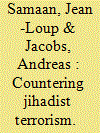

|
|
|
|
|
| Summary/Abstract |
As France and Germany have become major targets of jihadist terrorism, the calls for stronger cooperation in counterterrorism at the European level have grown in earnest. However, a comparative analysis of the national experiences from both countries evidences significant differences in terms of political culture, institutional division of labor, and legal oversight. Counterterrorism practices can be described following a typology of three broad categories: a military-oriented policy that aims to prevent, deter and retaliate against terrorists; a regulatory policy that strengthens the legal and judicial resources to address the terrorist threat; a diplomatic approach that focuses on negotiations, and sometimes accommodation. Whereas France moved after the 2015 attacks towards a military-oriented policy, Germany has so far opted to sustain its traditional regulatory approach. This article details the differences between Paris and Berlin regarding the contemporary public debate on jihadist terrorism, to the law enforcement framework, to the deradicalization programs as well as to the role of armed forces. The paper identifies a clear divergence in each of these sectors. As the future extent of bi- and multilateral lateral efforts in the field of counterterrorism are likely to rise, these differences should be better taken into account.
|
|
|
|
|
|
|
|
|
|
|
|
|
|
|
|
| 8 |
ID:
172196
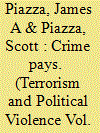

|
|
|
|
|
| Summary/Abstract |
What impact does engagement in crime have on terrorist group survival? In theory criminal activity may decrease group survival by damaging group legitimacy or prompting government crackdowns. Conversely, crime might boost group survival by facilitating access to revenues or by further taxing state policing capacity. Moreover, different types of crime might have different effects. We investigate the impact of crime on terrorist group survival using cross-sectional data on 578 terrorist groups observed between 1970 and 2007. We find that engagement in crime reduces a group’s chance of demise by around 50% and extends its lifespan by around 7 years on average. Terrorist groups involved in narcotics are less likely to end by police or military force, but are also less likely to win political concessions. We find that groups involved in extortion live the longest and are also less likely to end by force or by splintering.
|
|
|
|
|
|
|
|
|
|
|
|
|
|
|
|
| 9 |
ID:
172176
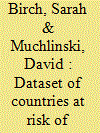

|
|
|
|
|
| Summary/Abstract |
Electoral violence is increasingly affecting elections around the world, yet researchers have been limited by a paucity of granular data on this phenomenon. This paper introduces and describes a new dataset of electoral violence—the Dataset of Countries at Risk of Electoral Violence (CREV)—that provides measures of 10 different types of electoral violence across 642 elections held around the globe between 1995 and 2013. The paper provides a detailed account of how and why the dataset was constructed, together with a replication of previous research on electoral violence. We introduce this dataset by demonstrating that the CREV, while measuring the same underlying phenomena as other datasets on electoral violence, provides researchers with the ability to draw more nuanced conclusions about the causes and consequences of violence that occurs in connection with the electoral process. We also present and analyze descriptive data from the CREV dataset.
|
|
|
|
|
|
|
|
|
|
|
|
|
|
|
|
| 10 |
ID:
172187
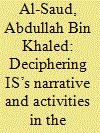

|
|
|
|
|
| Summary/Abstract |
The self-proclaimed Islamic State (IS) has never ceased targeting, verbally and physically, the Kingdom of Saudi Arabia. While it might be easy to know why, it is harder, but more important, to understand how. Since Abu Bakr al-Baghdadi proclaimed the establishment of a wilaya (province) in the land of the two Holy Mosques in November 2014, thirty-two IS-linked terrorist operations took place in Saudi Arabia. Based on primary source materials produced by IS, and an examination of its footprint in Saudi Arabia, this article explains the calculus behind IS’s strategy and objectives in Saudi, shows the main themes of its narrative and how it tailors its strategic communications campaign to the specific historical and social context of the country, and illustrates how it tries to exploit and claim the Saudi religious heritage. The article also examines to what extent IS’s activities and operations reflect its rhetoric and purported strategy, describes the structure it adopts inside the Kingdom, and demonstrates why the momentum of its violent campaign has faltered in recent months.
|
|
|
|
|
|
|
|
|
|
|
|
|
|
|
|
| 11 |
ID:
172200
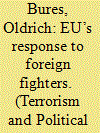

|
|
|
|
|
| Summary/Abstract |
The conflicts in Syria and Iraq have put foreign fighters—individuals travelling from other countries to engage in these conflicts—high on the security agenda at both the national and EU level. Drawing on theoretical arguments previously advanced to explain the haphazard evolution of the EU’s counterterrorism efforts after September 11, 2011, this articles discusses the emergence and persistence of key challenges that have hampered the EU response to security threats posed by 5,000 European foreign fighters between 2013 and early 2017. These include the absence of a common EU-level definition; the differences regarding the scope and perceptions of the threats posed to individual Member States; the lack of consensus on root causes of terrorism and radicalization; and the differences among Member States when it comes to addressing the difficulties of criminal prosecution of foreign fighters.
|
|
|
|
|
|
|
|
|
|
|
|
|
|
|
|
| 12 |
ID:
172193
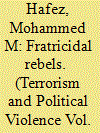

|
|
|
|
|
| Summary/Abstract |
Why do rebels kill each other? When confronting a formidable regime, rebels often descend into warring factionalism rather than forge unity across their ranks to reap the advantages of cooperation. This article tackles the puzzle of inter-rebel fratricide. It explores power and resource competition arguments, and contrasts them with ideological mechanisms that can drive inter-rebel violence. It argues that ideological extremity is central to rebel fratricide. Rebel organizations with common ideological origins can still compete with each other based on their degree of centrism and extremism, making them ideologically distant. This proximity-distance paradox makes their cohabitation mutually threatening. Ideological challengers from the same family tree are particularly threatening to one’s group cohesion, and if successful, guarantee one’s political marginalization within the broader movement. Extremist groups are likely to respond to these threats with fratricide, while ideologically centrist ones will rely on other strategies such as balancing, outbidding, or defecting to manage their rivalries. Algeria’s civil war, 1992–2002, is a plausibility probe case study that illustrates these causal mechanisms. The study contributes to a burgeoning literature on the role of ideology in armed civil conflicts.
|
|
|
|
|
|
|
|
|
|
|
|
|
|
|
|
| 13 |
ID:
172172
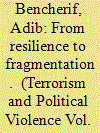

|
|
|
|
|
| Summary/Abstract |
During the last decade, Al Qaeda in the Islamic Maghreb (AQIM) managed to survive despite suffering four major fragmentations. Through the case study of AQIM, the goal of this paper is to contribute theoretically and empirically to the literature on terrorism by explaining the fragmentation of resilient jihadist groups. Two causes of fragmentation are identified: the “preference divergence,” in reference to the works of Shapiro, and the structural organization of power. Furthermore, two notions are presented to refine the theoretical tools of the literature on terrorism: a) the meta-strategy of survival, and b) centralized and deconcentrated power. To explore the group’s history and demonstrate the modularity of AQIM, a triangulation of primary sources, such as internal documents and key interviews, along with the monitoring of the regional press, is utilized. The author concludes this paper by suggesting new avenues for studying the evolution of jihadist groups.
|
|
|
|
|
|
|
|
|
|
|
|
|
|
|
|
| 14 |
ID:
172184


|
|
|
|
|
| Summary/Abstract |
While evidence has suggested that international assistance projects become the targets of violence, political science research has often addressed this relationship at the state level and not the aid location itself. Given the heterogeneous nature of aid distribution and terrorist behavior within a state, it is important to study this relationship using higher resolution data. Using geocoded terrorist attack and multilateral aid distribution data, coupled with the PRIO-GRID cell structure, our approach sheds light on whether areas in which aid is distributed are more likely to be targeted by terrorist groups. Our results show that areas where aid is being distributed are targeted more heavily than areas without aid distribution. The modality of specific multilateral aid projects is also shown to impact whether they are more likely to be targeted. Further, we show that terrorists select different types of targets in aid locations than they do in non-aid locations, lending support to the notion that terrorists seek to intimidate local populations from collaboration with the government and to dissuade further government efforts. The results not only highlight and expand upon the dangers associated with aid distribution, but also the notion that aid content is a factor in terrorist targeting preferences.
|
|
|
|
|
|
|
|
|
|
|
|
|
|
|
|
| 15 |
ID:
172192
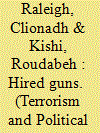

|
|
|
|
|
| Summary/Abstract |
Pro-government militias (PGMs) are armed, political organizations that assist regime and state elites through illicit violence. This article considers how and where to situate militias within larger frameworks of political violence and its emerging contexts. Pro-government militias have increased in recent years, along with their participation in conflict events, including those resulting in fatalities. This is in step with increases in domestic political competition and regime fragmentation across developing states. Using a new PGM dataset that collects discrete events perpetrated by these groups across Africa from 1997–2016, two conclusions are reached: PGM groups are more active outside of civil war periods than within, and their actions and numbers have increased as more countries transition to democracy. Further, activity by PGMs is not well explained by government attempts to delegate violence for reputational reasons or low capacity. Political fragmentation at the national level and diffuse opposition threats better account for the spatial and temporal patterns of PGM activity.
|
|
|
|
|
|
|
|
|
|
|
|
|
|
|
|
| 16 |
ID:
178899
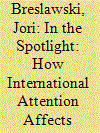

|
|
|
| 17 |
ID:
172191
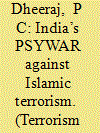

|
|
|
|
|
| Summary/Abstract |
Islamic terrorism in India has posed a formidable threat to India’s national security. A result of inimical state policies from India’s north-western borders as well as home-grown radicalisation, it has developed into a threat that demands a multi-faceted approach in order to be contained. Counterterrorism strategies to defeat the threat need reliance on psychological warfare in combination with offensive operations. This article, therefore, examines the current state of India’s strategic psychological operations against Islamic terrorism and prescribes a Trident Strategy for effective counterterrorist operations. On observation of the counterterrorist successes in Punjab, the Trident Strategy is composed of a strong political will, proactive action and propaganda machinery.
|
|
|
|
|
|
|
|
|
|
|
|
|
|
|
|
| 18 |
ID:
172197
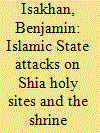

|
|
|
|
|
| Summary/Abstract |
After conquering large swaths of Syria and Iraq, the IS undertook an aggressive sectarian campaign in which they not only enacted horrific violence against the Shia people, but also damaged or destroyed several key Shia mosques and shrines. Drawing on Social Movement Theory (SMT), this article analyzes the response by various Shia non-state actors—militia leaders, religious clergymen, populist preachers, and seminal poets. It argues that they used the IS threat to Shia holy sites to develop and deploy a mobilization frame that has come to be referred to as the “shrine protection narrative.” The article also documents the manifold consequences of the shrine protection narrative: it underpinned a mass recruitment drive that saw tens of thousands enlist; it legitimized foreign Shia militias to enter the conflicts in both Syria and Iraq; it justified the formation of entirely new militias who declared the centrality of shrine protection to their mandate; and it mobilized them to enact political violence. In doing so, this article extends existing studies of SMT to demonstrate that “sacred spaces”—and particularly the need to protect religious sites from specific threats—can serve as a powerful mobilization frame towards political violence.
|
|
|
|
|
|
|
|
|
|
|
|
|
|
|
|
| 19 |
ID:
172169
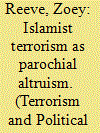

|
|
|
|
|
| Summary/Abstract |
An evolutionary approach is used to explain how certain universal cognitive mechanisms (parochial altruism) underlie engagement and involvement in Islamist terrorism. Parochial altruism is the tendency to perceive and behave in ways that favour ingroups and disfavour outgroups in light of particular intergroup cues, whilst incurring some kind of personal cost to effect that bias. The parochial altruism mechanism influences how ingroups and outgroups are perceived (i.e., as threatened or threatening) and responded to. Experience of certain situations and/or dispositions (i.e., priming contexts of disease, and harm to the ingroup) make parochial altruistic responses more likely. It is argued that Islamist terrorist grievances can be considered as perceptions of evolutionarily relevant threats, whilst terrorism itself is an example of parochial altruistic behaviour. It is further proposed that features associated with engagement in terrorism (including exposure to ideology, propaganda, socialisation, etc.) enhance and guide parochial altruism, that is, perceptions of intergroup threat, and violent responses to it.
|
|
|
|
|
|
|
|
|
|
|
|
|
|
|
|
| 20 |
ID:
172183
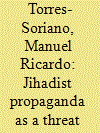

|
|
|
|
|
| Summary/Abstract |
The present article examines the relevance of jihadist propaganda as an indicator of the threat from terrorism. To that end, it uses jihadist propaganda output referring to Spain as a case study. It proposes an instrument of measurement based on content analysis, in which the origin, format, content, and distribution method of the materials are taken as categories. The results offer empirical evidence regarding the seriousness of the terrorist threat against Spain, a country that is particularly exposed due to its historical and geographical singularities and its status as the victim of an attack deemed paradigmatic in the minds of jihadists.
|
|
|
|
|
|
|
|
|
|
|
|
|
|
|
|
|
|
|
|
|